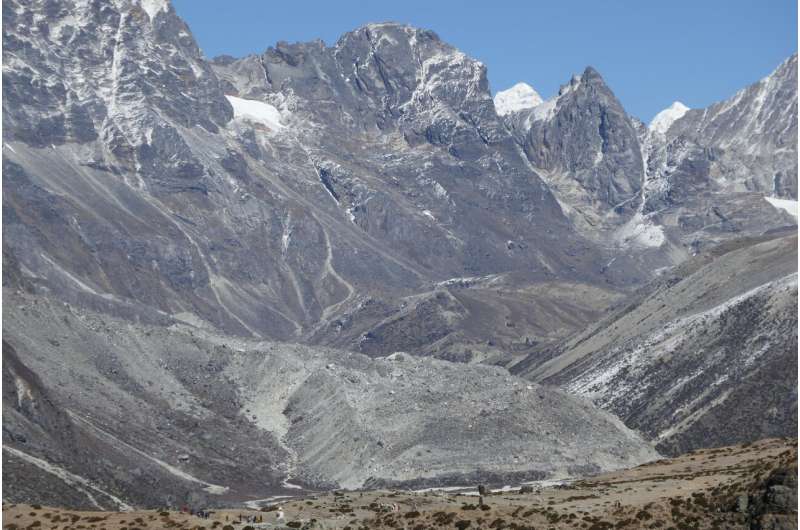Rock glaciers will slow Himalayan ice melt

Some Himalayan glaciers are more resilient to global warming than previously predicted, new research suggests.
Rock glaciers are similar to "true" ice glaciers in that they are mixtures of ice and rock that move downhill by gravity—but the enhanced insulation provided by surface rock debris means rock glaciers will melt more slowly as temperatures rise.
Rock glaciers have generally been overlooked in studies about the future of Himalayan ice.
The new study, led by Dr. Darren Jones at the University of Exeter, shows rock glaciers already account for about one twenty-fifth of Himalayan glacial ice—and this proportion will rise as exposed glaciers continue to melt and some transition to become rock glaciers.
"Glaciers play a vital role in regulating water supplies, and Himalayan glaciers regulate water for hundreds of millions of people," said Professor Stephan Harrison, of the University of Exeter.
"Over the past century, these glaciers have lost about 25% of their mass due to climate change, and they are predicted to lose more in the future.
"However, glacier models have treated glaciers as uniform lumps of ice—and our study shows not all glaciers will melt at the same rate.
"Many are covered in rock and are in various stages of the transition to rock glaciers.
"These slow-moving glaciers are well insulated, and as a result they are more resilient to global warming than 'true' glaciers."
The study has provided the first estimate of the number and importance of rock glaciers in the Himalayas.
It shows that there are about 25,000 rock glaciers in the region, containing a total of about 51 cubic kilometres of ice—or 41-62 trillion litres of water.
Despite this, lead author Dr. Darren Jones cautioned: "Although we find that rock glaciers are more resilient to warming, it remains clear that all Himalayan glaciers are in long-term decline, with enormous implications for the people who rely on them for water supplies."
"Further research into Himalayan rock glaciers is critical for underpinning climate change adaptation strategies and to ensure that this highly populated region is in a strong position to meet sustainable development goals," said Professor Richard Betts, of the Met Office Hadley Centre and the University of Exeter, who was also involved in the study.
The research team included Dr. Karen Anderson at the University of Exeter and Dr. Sarah Shannon at the University of Bristol.
Funders included the Natural Environment Research Council, GW4 Ph.D. funding to Dr. Darren Jones, and the BEIS/Defra Met Office Hadley Centre Climate Programme.
The paper, published in the journal Science of the Total Environment, is entitled: "Rock glaciers represent hidden water stores in the Himalaya."
More information: D.B. Jones et al, Rock glaciers represent hidden water stores in the Himalaya, Science of The Total Environment (2021). DOI: 10.1016/j.scitotenv.2021.145368
Journal information: Science of the Total Environment
Provided by University of Exeter


















